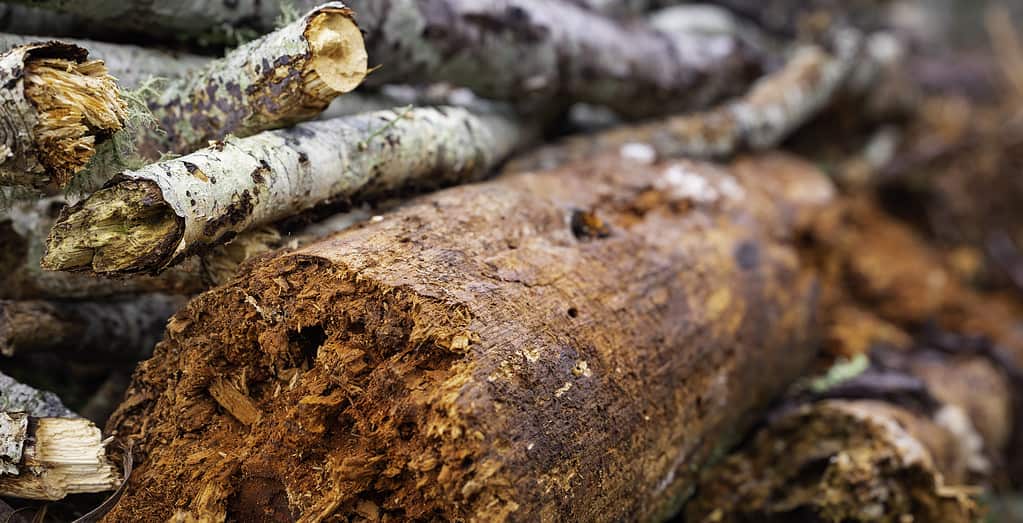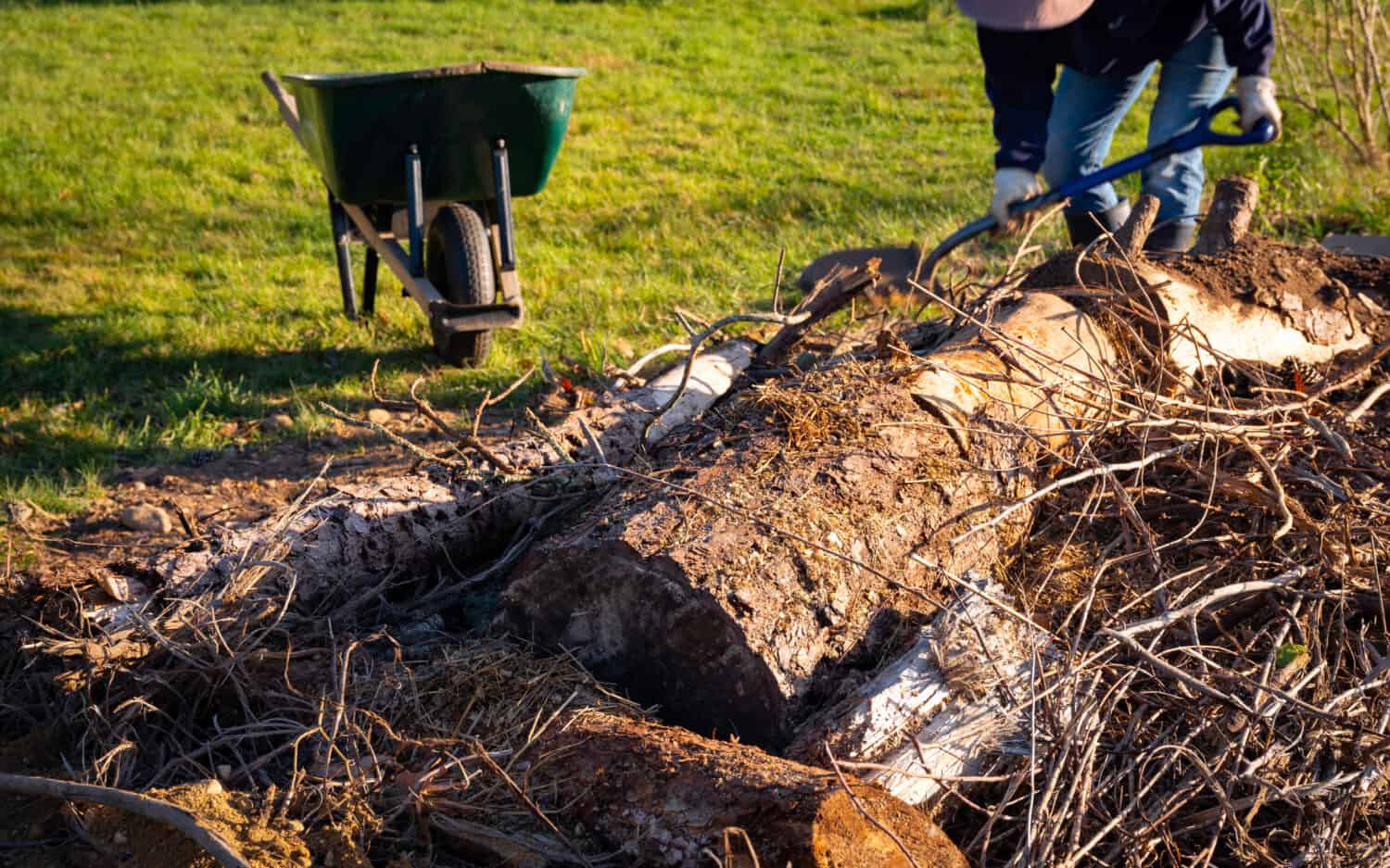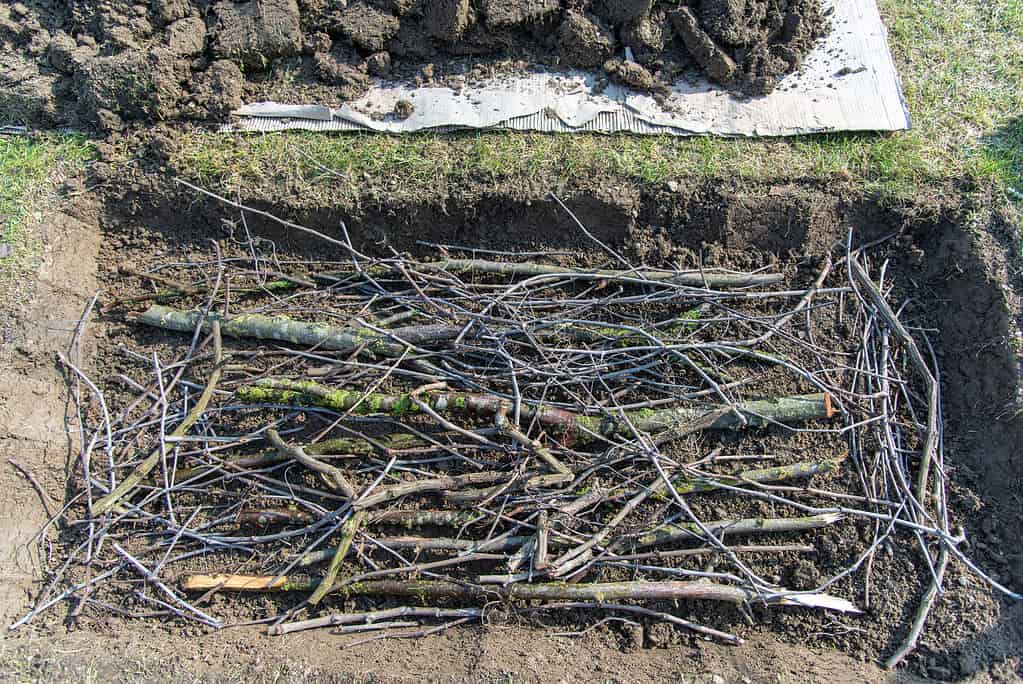Hugelkultur gardens, a fascinating twist on traditional gardening, are gaining popularity among eco-conscious enthusiasts. The German term meaning “hill culture” involves creating raised garden beds using logs, branches, and organic materials. These beds act like sponges, retaining moisture and nutrients, which can result in bountiful harvests with less watering and fertilizing.
Building a hugelkultur garden is an eco-friendly way to enrich your soil, reduce waste, and grow a thriving garden. In this article, we’ll explore various types of hugelkultur gardens and walk you through the steps to build your own.
What is a Hugelkultur?
Hugelkultur represents an innovative and sustainable gardening technique. Rooted in traditional European farming practices, hugelkultur beds are essentially raised garden beds constructed on mounds of decomposing organic matter and woody debris. This ancient concept has garnered renewed interest in recent years, proving itself as an efficient and eco-friendly approach to cultivating a variety of crops and ornamental plants.
The Function of Hugelkultur
Hugelkultur operates on a fundamental principle of imitating natural decomposition processes, reminiscent of those found in forests, where fallen trees and organic materials accumulate and break down over time. In a hugelkultur bed, the bottom layer is composed of logs, branches, and other woody materials. This layer functions like a sponge, capable of retaining moisture.
As these materials decompose gradually, they release nutrients into the soil. On top of this woody base, layers of organic matter such as leaves, grass clippings, kitchen scraps, and other compostable materials are added. These layers decompose slowly, providing a continuous and sustainable source of nutrients for the plants.
The Benefits of Hugelkultur
Hugelkultur offers a multitude of benefits that make it an attractive choice for gardeners:
- Enhanced Moisture Retention: The woody foundation of hugelkultur beds efficiently stores rainwater and moisture, subsequently releasing it slowly into the soil. This unique feature makes hugelkultur beds highly resistant to drought conditions.
- Nutrient-rich soil: As the organic matter decomposes, it enriches the soil with essential nutrients, creating a fertile environment that is conducive to robust plant growth. Gardeners often find that plants grown in hugelkultur beds flourish with minimal need for additional fertilizers.
- Reduced Watering Needs: Thanks to the exceptional moisture retention capabilities of hugelkultur beds, gardeners typically need to water less frequently, a significant advantage in regions with water scarcity or during periods of drought.
- Extended Growing Seasons: Hugelkultur beds have the potential to remain productive for many years, as the slow decomposition process ensures a consistent supply of nutrients. This feature enables gardeners to extend their growing seasons and engage in year-round gardening, even in climates with challenging weather conditions.
- Minimal Weeding: The mulch layer placed on top of hugelkultur beds serves to suppress weed growth, which reduces the time and effort required for weeding and garden maintenance.
- Sustainability: Hugelkultur promotes sustainability by recycling organic waste and utilizing natural materials. It diminishes the volume of waste sent to landfills and conserves valuable resources.
The History of Hugelkultur
While the term “hugelkultur” is of German origin, the practice of creating raised garden beds on mounds of organic matter has ancient roots. Historically, Eastern European cultures, particularly in regions like Poland and Germany, employed similar techniques. However, the modern term “hugelkultur” and the systematic approach associated with it were popularized by Sepp Holzer, an Austrian permaculturist, farmer, and visionary.
Sepp Holzer is widely acknowledged for bringing hugelkultur into the spotlight of sustainable gardening practices. He developed and refined the method on his farm, located in the Austrian Alps, where he successfully demonstrated its effectiveness across various climates and terrains. Holzer’s pioneering work with hugelkultur beds has inspired gardeners worldwide to embrace this eco-friendly gardening technique and adapt it to their specific needs.
With all of this in mind, let’s look at some ways to build an amazing hugelkultur-raised bed for your garden or homestead!
1. Traditional Raised Bed Hugelkultur

Traditional raised bed hugelkulturs typically involve little to absolutely no digging.
©Sanghwan Kim/iStock via Getty Images
To build a traditional raised bed hugelkultur, start by selecting a suitable location with good sunlight. Choose the dimensions of your bed, typically three to four feet wide and as long as desired. Begin by digging a trench about one to two feet deep. Lay down logs or large branches in the trench to form the base. This wood acts as a sponge, absorbing and retaining moisture over time.
Next, add layers of organic matter such as leaves, grass clippings, and kitchen scraps. Alternate green (nitrogen-rich) and brown (carbon-rich) materials to create a balanced composting environment. Continue layering until the bed is about a foot above ground level.
Cover the mound with a layer of topsoil, ensuring good contact between soil and wood. Finally, mulch the surface to conserve moisture and suppress weeds.
The benefits of a hugelkultur bed are numerous. First, it’s an eco-friendly way to recycle organic waste, reducing landfill contributions. The decomposing wood provides a long-term source of nutrients for plants, promoting healthy growth. Hugelkultur beds also retain moisture effectively, reducing the need for frequent watering, and they are less prone to drought stress. Over time, the bed becomes a self-sustaining ecosystem, attracting beneficial insects and microorganisms.
Also, raised beds make gardening more accessible, with less bending and kneeling required. Overall, hugelkultur beds are a sustainable and efficient gardening method that yields bountiful harvests while minimizing environmental impact.
2. Keyhole Hugelkultur
To create a keyhole hugelkultur, begin by selecting a sunny location in your garden. This unique raised bed design incorporates a central, circular opening resembling a keyhole, making it accessible from all sides. Start by outlining the circular center, typically around six feet in diameter, with bricks, stones, or wood. This will be the “keyhole” pathway for easy access.
Next, dig a trench around the circular center about one to two feet deep. In this trench, place logs or large branches, creating the foundation of your hugelkultur bed. These woody materials will serve as a sponge, storing moisture and slowly releasing it to your plants.
Layer on top of the wood with organic matter, such as leaves, grass clippings, kitchen scraps, and other compostable materials. Alternate green and brown materials to achieve a balanced mix. Finish by adding a layer of topsoil over the organic matter.
What makes the keyhole hugelkultur unique is its circular design, which maximizes planting space while allowing convenient access from all sides. You can grow a variety of vegetables and herbs in this bed, including tomatoes, peppers, cucumbers, zucchini, basil, and more. The decomposing wood and organic matter in the bed provide a consistent source of nutrients, promoting healthy plant growth. The keyhole design also allows for efficient space utilization, making it an excellent choice for small gardens or areas with limited space. Overall, keyhole hugelkultur beds offer a productive and accessible gardening solution.
3. Modern Raised Bed Hugelkultur

Modern and traditional hugelkulturs all share the same core structure and function.
©NayaDadara/Shutterstock.com
To construct a modern raised bed hugelkultur, first, select a sunny location in your garden. Unlike traditional hugelkultur beds that are often ground-level mounds, modern raised bed hugelkulturs are built within a raised structure. Create a rectangular or square frame using materials like wood or stone. The height can vary, but typically, these beds are built to be waist-high to make gardening more accessible.
Inside the frame, start by placing logs or large branches. These serve as the base, soaking up moisture and slowly releasing it into the soil. On top of the wood, add layers of organic matter such as leaves, grass clippings, and kitchen scraps. Alternate green and brown materials to encourage decomposition.
Top off the mound with a layer of quality topsoil, ensuring good contact between soil and wood. You can also add mulch to conserve moisture and suppress weeds.
What sets modern raised bed hugelkulturs apart is their elevated structure. They offer several advantages, including better accessibility for gardeners with mobility issues, reduced bending and kneeling, and a tidy appearance that can fit seamlessly into modern garden designs.
Additionally, the raised height provides better drainage and prevents waterlogged roots. The combination of decomposing wood and organic matter ensures long-term nutrient availability for plants. Modern raised bed hugelkulturs are an excellent option for those looking for a convenient, productive, and visually appealing gardening solution.
4. Terrace Hugelkultur
To create a terrace hugelkultur, you’ll need a sloped or hilly area in your garden. This design is unique because it adapts hugelkultur principles to address the challenges of uneven terrain. Instead of mounds or raised beds, terrace hugelkulturs involve building a series of level, horizontal terraces along the slope.
Start by marking out the contours of your terraces using stakes and string. These terraces can be as wide or narrow as you prefer, but typically, they’re three to four feet wide. Dig a trench along the contour line, removing soil from the uphill side to create the terrace. The depth of the trench depends on your materials, but aim for about one to two feet.
Place logs or large branches in the trench as the foundation. These woody materials will absorb and hold moisture. On top of the wood, layer organic matter, such as leaves, grass clippings, and kitchen scraps. Alternate between green and brown materials to achieve a balanced mix.
Finally, cover the mound with a layer of quality topsoil, ensuring good soil-wood contact. Plant your crops or ornamentals directly in the topsoil.
Terrace hugelkulturs are unique because they maximize planting space on sloped terrain while preventing soil erosion. The terraced design offers better water retention, and the decomposing wood and organic matter provide a steady source of nutrients. This innovative approach transforms challenging landscapes into productive and sustainable garden spaces.
5. Container Hugelkultur
Creating a container hugelkultur garden offers an adaptable and space-efficient approach to harness the benefits of hugelkultur in small or urban environments. This method is unique due to its suitability for constrained spaces and vertical gardening.
Begin by selecting a suitable container, such as a large pot, planter box, or raised bed. Ensure the container has proper drainage holes to prevent waterlogging. The foundational layer of your container hugelkultur consists of woody materials. Place sticks, branches, or logs at the bottom. This layer serves as a reservoir for moisture retention.
Layer organic matter on top of the woody base. Combine kitchen scraps, leaves, grass clippings, and other compostable materials. The alternation between green and brown materials facilitates balanced decomposition. Cover the organic matter with a layer of high-quality topsoil. Compact the soil to ensure good contact with the underlying materials.
Now, you’re ready to plant. Choose a variety of vegetables, herbs, or flowers that suit your container’s size. Follow standard planting guidelines, ensuring proper spacing.
What sets container hugelkultur apart is its adaptability to limited spaces. It maximizes vertical gardening potential, making it ideal for balconies, patios, or small yards.
6. Sunken Hugelkultur

A high-angle shot of twigs and logs laid on the ground for hugelkultur raised beds
©Wirestock/iStock via Getty Images
Building a sunken hugelkultur bed involves a distinct approach to hugelkultur gardening. It’s unique compared to other designs because it takes advantage of natural depressions or excavated areas.
First, locate or dig a depression in your garden, typically about two to three feet deep. This sunken bed will allow you to harness the benefits of hugelkultur while maintaining a more level garden surface.
Next, place logs or large branches at the bottom of the depression. These woody materials will serve as the foundation, absorbing and retaining moisture over time.
Layer organic matter, such as leaves, grass clippings, kitchen scraps, and other compostable materials, on top of the wood. Alternate between green and brown materials to promote balanced decomposition. Cover the area with a layer of good topsoil, ensuring good contact between the soil and the underlying materials.
The sunken hugelkultur bed’s uniqueness lies in its utilization of existing or naturally formed depressions, which can be particularly advantageous in areas with uneven terrain. This design effectively captures and stores moisture, making it an efficient choice for regions with erratic rainfall or dry spells. Additionally, it allows for easier access and maintenance compared to traditional hugelkultur mounds. Sunken hugelkulturs also provide a steady source of nutrients, promoting healthy plant growth, and are an innovative way to make the most of your garden’s topography.
7. Hybrid Hugelkultur

Hybrid hugelkulturs are great for experienced gardeners who want to blend the benefits of hugelkultur types into one single or one group of mounds.
©Kuznetsov Dmitriy/Shutterstock.com
Constructing a hybrid hugelkultur combines the principles of traditional hugelkultur with raised bed gardening. This approach offers the advantages of both methods, making it unique in its versatility. Here’s a guide on how to build one:
Start by selecting a location in your garden and defining the dimensions of your raised bed. Hybrid hugelkultur beds typically have a frame made of wood or other suitable materials. This frame can be of varying heights, but it’s commonly built to waist level for ease of gardening.
Within the frame, place logs or large branches as the foundation. These woody materials will absorb and retain moisture, essential for plant health.
Add layers of organic matter on top of the wood, alternating between green and brown materials. This combination promotes decomposition and nutrient release. Cover the mound with high-quality topsoil, ensuring good contact between soil and wood. This top layer is where you’ll plant your crops or ornamentals.
The unique aspect of a hybrid hugelkultur is the blend of hugelkultur’s moisture-retention and nutrient-rich qualities with the convenience and accessibility of a raised bed.
Summary of Ways to Build Amazing Hugelkultur Raised Beds
| # | Methods |
|---|---|
| 1 | Traditional Raised Bed Hugelkultur |
| 2 | Keyhole Hugelkultur |
| 3 | Modern Raised Bed Hugelkultur |
| 4 | Terrace Hugelkultur |
| 5 | Container Hugelkultur |
| 6 | Sunken Hugelkultur |
| 7 | Hybrid Hugelkultur |
The photo featured at the top of this post is © Sanghwan Kim/iStock via Getty Images
Thank you for reading! Have some feedback for us? Contact the AZ Animals editorial team.







